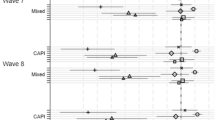Abstract
The current paper deals with the issue of the detection of selective nonresponse in discrete-time, multi-wave panel studies. If groups in a population differ with respect to the chances that they will be (and remain) in a longitudinal sample, we speak of selective nonresponse. Ultimately, selective nonresponse may lead to a sample that is very different from the target population. We discuss ways to detect and quantify the amount of selectiveness by means of discrete-time Markov models. Then we proceed by addressing how a researcher may gain understanding of how to solve the problems caused by selective nonresponse, and the degree to which these solutions will be effective, by means of data on the nonresponse during a three-wave panel study involving 2800 young Dutch adults.
Similar content being viewed by others
Reference
Anderson, T. W. (1954). Probability models for analyzing time changes in attitudes. In P. F. Lazarsfeld (ed.), Mathematical Thinking in the Social Sciences. Glencoe, IL: The Free Press.
Bartholomew, D. J. (1981). Mathematical Models in Social Science. New York: Wiley.
Coleman, J. S. (1968). The mathematical study of change. In H. M. Blalock & A.B. Blalock (eds.), Methodology in Social Research (pp. 428–478). New York: McGraw-Hill.
Dijkstra, W. & Smit, J. (1989). Nonrespons (Nonresponse). In W. Dijkstra (ed.), Het proces van sociale integratie van jong-volwassenen: De gegevensverzameling voor de eerste hoofdmeting (pp. 59–70). Amsterdam: VU-Uitgeverij.
Goyder, J. (1987). The Silent Minority. Cambridge: Blackwell University Press.
Taris, T. W. (1995). Nonrespons en representativiteit in panel studies: Fen korte notitie (Nonresponse and representativity in panel studies: A short note). Kwantitatieve Methoden 16, 41–44.
Taris, T. W. (1996). Modeling nonresponse in multiwave panel studies using discrete-time Markov models. Quality & Quantity 30: 189–203.
Taris, T. W., Van der Vaart, W. & Dijkstra, W. D. (1993). Nonrespons en de representativiteit van de follow-up metingen (Nonresponse and representativity of the follow-up waves). In W. D. Dijkstra (ed.), Het proces van sociale integratie van jong-volwassenen; De gegevensverzameiing voor de tweede hoofdmeting (pp. 65–76). Amsterdam: VU-Uitgeverij.
Tuma, N. B. & Hannan, M. T. (1984). Social Dynamics; Models and Methods. New York: Lawrence Eribaum.
Van de Pol, F. J. R. (1989). Issues of Design and Analysis of Panels. Amsterdam: Sociometric Research Foundation.
Van de Pol, F. J. R., De Jong, W. & Langeheine, R. (1990). PANMARK 2.2 User Manual: Panel Analysis Using Markov Chains. Groningen: IEC ProGAMMA.
Van de Pol, F. J. R. & Langeheine, R. (1989). Mixed Markov latent class models, from description toward explanation. In C. C. Clogg (ed.), Sociological Methodology 1990.
Author information
Authors and Affiliations
Rights and permissions
About this article
Cite this article
Taris, T.W. On selectivity of nonresponse in discrete-time multi-wave panel studies. Quality & Quantity 31, 79–93 (1997). https://doi.org/10.1023/A:1004210432605
Issue Date:
DOI: https://doi.org/10.1023/A:1004210432605




